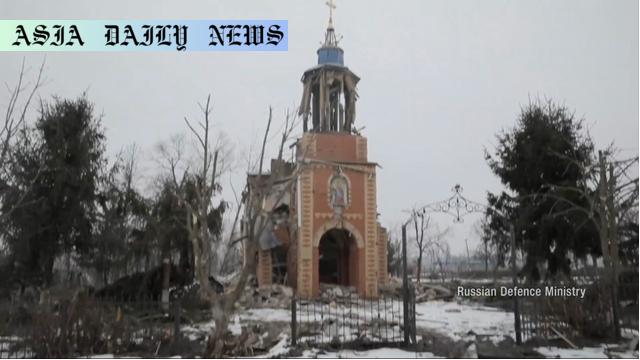Kursk: Ukrainian soldier highlights grim situation, attributes heavy losses to advanced Russian tactics and technology.
- Kursk: Ukrainian soldier admits to unfavorable battle conditions.
- Russia’s fiber-optic drones responsible for 95% losses.
- North Korean forces in Kursk exhibit improved training and coordination.
- Russian offensive nearing completion as encirclement looms.

Unfolding Situation in Kursk: A Soldier’s Perspective
The battle in the Russian region of Kursk marks another critical development in the ongoing conflict between Ukraine and Russia. A Ukrainian soldier stationed in Kursk recently revealed that the dynamic of this conflict has shifted unfavorably for Ukraine. Reporting from the beleaguered town of Sudzha, the soldier detailed mounting challenges faced by Ukrainian forces.
According to reports, Russian forces have made significant tactical advancements, with a major breakthrough in Ukraine’s defensive lines south of Sudzha. This was attained with substantial reliance on new military strategies, including the utilization of North Korean soldiers, a detail that signifies a noticeable shift in the quality and coordination of allied forces on the Russian side. Ukrainian media, including Suspilne, suggest that these soldiers demonstrate improved training and effectiveness compared to their earlier deployment during other conflicts.
Russia’s Modern Tactics: Fiber-Optics and Coordinated Offensives
One particularly devastating element of the Russian offense has been their deployment of fiber-optically controlled drones. These unmanned aerial vehicles (UAVs) have proven to be highly effective tools in the conflict, reportedly rendering Ukraine’s radio interference efforts impotent. According to the Ukrainian soldier’s account, these drones account for approximately 95% of the losses in Ukraine’s fire positions and military equipment. This figure underlines the technological disparity currently impacting the outcome of the battle in Kursk.
The inclusion of fiber-optic control marks a technological leap, as these drones are immune to conventional jamming techniques. This advancement underscores the evolving nature of modern warfare, where technological superiority often dictates battlefield outcomes.
Encirclement in Sudzha: The Encroaching Russian Strategy
The geographic and strategic situation worsens for Ukraine as reports increasingly signal a successful encirclement maneuver by Russian forces in Sudzha. Russian officials, including Dmitry Medvedev, deputy chair of Russia’s Security Council, have expressed growing confidence in their operations. Medvedev’s recent social media post proclaimed, “The lid of the smoking cauldron is almost closed,” suggesting that Ukrainian forces in Kursk might face complete entrapment soon.
Ukrainian President Volodymyr Zelenskyy has acknowledged the intensifying aggression from the Russian side. Echoing the gravity of the situation, he reported on social media that hundreds of attacks have been executed by Russian forces throughout the week, employing various types of weaponry. This intensification of offensive strategies signals a calculated push by Russia to secure territory and dismantle Ukrainian resistance.
The Broader Implications of the Kursk Battle
The developments in Kursk carry significant implications for the broader conflict. The involvement of North Korean forces highlights increasingly global dimensions in the war while underscoring the necessity for Ukraine to address not only its conventional military tactics but also its technological capabilities. The suspension of U.S. military aid compounds challenges for Ukraine, as they face an enemy enhanced by both manpower and advanced technology.
The battle for Kursk offers a somber view of the evolving nature of warfare. It is a reminder that strategic innovations—be it technological advancements or tactical alliances—can drastically redefine conflict outcomes on the battlefield.



Commentary
The Sobering Reality of the Kursk Offensive
The situation unfolding in Kursk is yet another testament to the enduring complexities of the conflict between Ukraine and Russia. Hearing a Ukrainian soldier openly admit that the battleground dynamics are unfavorable for his side is a stark reminder of the human element in warfare. These are not just tactical maneuvers or technological deployments; they are stories of individuals reckoning with an ever-evolving, perilous situation while representing their country under duress.
Technological Superiority Dictates the Battle
One of the most significant takeaways from the developments in Kursk is the role technological advancements play in modern combat. The reported efficacy of Russia’s fiber-optic drones is shocking but unsurprising. As warfare evolves, so too does the integration of cutting-edge technology. Fiber-optically controlled UAVs immune to radio interference represent a devastating new frontier of asymmetric warfare where even well-prepared armies can be blindsided by superior tech.
This also emphasizes a continued challenge for Ukraine: their technological parity. Despite substantial aid over the years, matching Russia’s unconventional tactics seems increasingly daunting, especially when other factors—such as the recent suspension of U.S. military aid—impact their preparedness.
The Crossroads Ukraine Faces
Ukraine now finds itself at a critical juncture. With reports of encroachment and encirclement in Sudzha, the Kursk scenario could offer a grim precedent for future engagements along these battlefront regions. Will the country be able to regroup, recalibrate, and mount effective defenses, or will it further succumb to Russia’s superior strategies?
For international observers, this serves as a sobering call to action. The evolving situation in Kursk is not an isolated event but part of a much larger, devastating conflict that requires continued scrutiny, dialogue, and commitment from the global community.